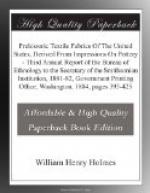[Illustration: Fig. 77.—From ancient pottery, Georgia.]
The example given in Fig. 78 differs from the preceding in the spacing and pairing of the warp cords. It was obtained from a fragment of ancient pottery recently collected at Reel Foot Lake, Tennessee.
[Illustration: Fig. 78.—From ancient pottery, Tennessee.]
Fig. 79 represents another interesting specimen from the pottery of the same locality. The border is woven somewhat differently from the body of the fabric, two threads of the woof being included in each loop of the warp.
[Illustration: Fig. 79.—From ancient pottery, Tennessee.]
Fig. 80 is from the pottery of the same locality. The threads are much more closely woven than those already given.
[Illustration: Fig. 80.—From ancient pottery, Tennessee.]
The next example, Fig. 81, impressed upon a fragment of clay from Arkansas, has been made of coarse, well-twisted cords. An ornamental border has been produced by looping the cords of the woof, which seem to have been five in number, each one passing over four others before recrossing the warp.
[Illustration: Fig. 81.—From a piece of clay, Arkansas.]
In no locality are so many fine impressions of textiles upon clay vessels found as in the ancient salt-making districts of the Mississippi Valley. The huge bowl or tub-like vessels used by the primitive salt-makers have very generally been modeled in coarse nets, or otherwise have had many varieties of netting impressed upon them for ornament.
In the accompanying plate (XXXIX) two fine examples of these impressions are given. They are somewhat more clearly defined than the majority of those from which the other illustrations are made.
Fig. 82 illustrates a specimen in which every detail is perfectly preserved. Only a small portion of the original is shown in the cut. The cords are heavy and well twisted, but the spacing is somewhat irregular. I observe one interesting fact in regard to this impression. The fabric has apparently been applied to the inverted vessel, as the loose cords of the woof which run parallel with the rim droop or hang in festoons between the cords of the warp as shown in the illustration, which is here placed, as drawn from the inverted fragment. The inference to be drawn from this fact is that the fabric was applied to the exterior of the vessel, after it was completed and inverted, for the purpose of enhancing its beauty. When we recollect, however, that these vessels were probably built for service only, with thick walls and rude finish, we are at a loss to see why so much pains should have been taken in their embellishment. It seems highly probable that, generally, the inspiring idea was one of utility, and that the fabric served in some way as a support to the pliable clay, or that the network of shallow impressions was supposed to act after the manner of a degraissant to neutralize the tendency to fracture.




